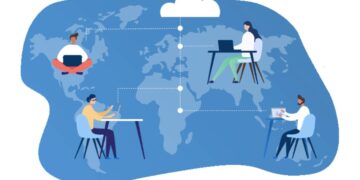An agile transformation is a big challenge because you broke with proven thought patterns. Recognizing the existing patterns and also developing new ways of thinking takes a lot of time and nerves. Our experts explain how agile transformation succeeds and which phases you should take into account for your procedure.

An agile transformation is a second-order change. That means: it is about a change of thought. This change of pattern is very challenging because our thinking patterns are often not so aware of it.
“Think First, Move Later”: to react directly, tighten the problems
To foster agile communication, we must first analyze the problem rather than rushing into solutions. For instance, companies can learn from Napster’s slower approach to innovation and recognize the importance of adapting to market developments, as seen in Spotify’s success.
Many customers: Little by little, to Spotify. What now? Napster would have to bring his developments to the market faster and more frequently in order to keep up.
If you are now “racing” in the situation of Napster to solve the problem, there is a risk of making more of the same: aggressive marketing, getting started with the price war, more projects at the same time, recruitment of Super-Dupa-Mega-Expert: Inside, formation of specialized task forces, setting up target agreements, bonification of the goal achievement, more controlling and status reporting, more pressure, etc.
Agile Transformation does not succeed with the usual ways of thinking
Embracing a logical approach is vital in agile transformation. These measures align with our conventional thinking habits, making them seem normal and feasible. Past success has reinforced their validity.
Many companies have been successful in the past 100 years. All you have to do is perfectly perfect and you are up again. Just as Albert Einstein said: “Problems can never be solved with the same way of thinking.” And so your company will consequently become even slower with these measures.
Agile Transformation means a change in the sample
To achieve the goal of being faster on the market, an agile transformation demands a completely different way of thinking and approach. Taking some distance from the problem and reflection time becomes essential for this paradigm shift.
Otherwise, there is a great risk to reproduce the known recipes again in autopilot mode. The HR Pioneers 5e Trafo Desirement shows you a way how to favor this change of thinking pattern for the jump to the next stage.
See Also: Kanban Vs Scrum: What’s The Difference?
How you can proceed with Agile transformation: the 5 Phases of Agile transformation proceedings
Procedure phase 1: Recognize – analyze problems and drivers of the change
In the process of agile transformation, the first crucial step is recognizing the existing problem. For instance, in the case of Napster, they observed a decline in contract renewals and decreased interest. Similarly, you need to identify symptoms and develop the determination to address the underlying issues.
In order to recognize these symptoms at all, you often have to widen your eyes first and take the symptoms seriously. It’s about developing an awareness of the problem. We often live so much in our own world, are caught in our hamster wheel so that we do not perceive changes in our environment or dismiss them as individual cases.
Napster, for example, could dismiss the falling key figures as a natural fluctuation for a long time. Only when you start to interview your cancellations: and the platforms of other music streaming providers: to look at the inside will your awareness will grow.
What you can do specifically in this phase:
- Analyze your environment: What has changed in the market and the customer: interior behavior? What do our competitors do: inside? How much are we affected by technological change? How does cooperation with our business partners work: inside? What is happening in politics and society? How well do we work together?
- Take a look at your company indicators!
- Which feedback do your employees give?
- Lead stakeholder: Inner interviews with customers: inside, business partner: inside, employees: inside, managers, work for councils, and who else moves in your “ecosystem“.
- Go actively looking for other perspectives! Go to conferences, read books and blog articles. See what the world is doing and what effects it has on you.
And in the best case, you do not do this alone, but with all those affected. Because as you did at first, it may also be your colleague: inside. They also do not notice that it is time to act. It has probably already happened to you that you were confronted with the question “But why? Everything is going. “Or” Oh, that goes by again! “To create the will to change, it is important to know that there is a serious problem: and not just for you, but in the whole area or companies. Kurt Lewin called this phase very plastic.
Procedure phase 2: Explore – perceive systemic patterns and penetrate
In the next step, it’s best to take some time to explore your systemic patterns. This is about making them visible and thus processable. That means switching off and observing your autopilot instead of reacting directly:

- What recurring phenomena are there in your organization?
- What leads to these phenomena? What does what work on? Which behavior regularly triggers which reactions?
- What influence does your culture have?
- Why do you do things as you do? What are the following beliefs, basic assumptions, and mental models?
In the case of Napster, the following would perhaps be recognized: the fewer projects will be completed, the more projects are restarted – perhaps also disguised as initiatives, task forces, or line activities (which are not). Behind it could be the faith: the more we start, the more we create. Or: Diamonds are created under pressure. Or: Whoever laughs still has reserves.
With the following instruments you can analyze the relationships:
- Power field analysis according to Kurt Lewin: What is moving in the direction you want in? What are helping forces? What blocks, hold back, and pulls in the opposite direction? Now you can see which strengths you want to strengthen and which blockers you can dissolve.
- You can also tackle the whole thing more elaborately and represent the individual forces in their interaction as system cycles: What does it affect what is strengthening or weakening? So you can find out the connections even better and where the lever can be used best.
- The 5-time WARUM question technology goes in a similar direction: Here you always ask “Why is that?” After the 5th time, you arrive at the root of the problem where you can start the lever.
- A good help against blind spots in organizational beliefs is the game “Play Change” by intensifying. Here typical beliefs in organizations are offered for discussion. There is also a list of practices related to these beliefs. You can use them to find out how and what faiths show and what they are strengthened.
- And of course, you can also do a location analysis in our Pioneers Trafo model ™. This gives you an overview of where you are on the dimensions of strategy, structure, process, HR instruments, leadership, and culture.
Procedure phase 3: emotionalize – develop your image of the future and make you tangible
With the previous phases, you have given your trinity body, mind, and soul the perfect food to enter the phase of emotionalization. This is about walking within: What do I want instead of the status quo?

- Take your time to pause, let room for a response to what was developed, and feel what you found out: emotions, body sensations, and intuition are other sources in addition to the purely cognitive intelligence that you use here.
- Sharp your own why, for example in the sense of the Ikigai, and exchange with your colleague: inside: What are you good at? What do you love? What does the world need? What can you be paid for?
- Get inspired! Not yet happening, use the instruments to look over the box from phase 1.
We call the phase emotionalizing, because if the future image is to and must break out of the now-made more conscious patterns, then you need more than your pure intellect. Breaking together, and acting under uncertainty – sorry, preferred reason – are increasingly emotional realms. Emotions are often a taboo subject in the professional context.
We always want to remain nicely factual. But evolution or not: we are still “emoted”. And emotions are not only much faster than our thoughts, but they are also primarily relevant to our decisions and our behavior. In order to get us in motion, a future image is therefore needed that attracts us emotionally.
At the same time, emotions are also transferred to others, so your moving image of the future can also have an attractive effect on others and ensure better identification.
Emotionalize by using the hands
Since emotions have no language in the first step, we are happy to use the intelligence of the hands to develop a future – before we, if at all, express it in language. For this, we provide the groups with whom we work, such as the following materials:
- Lego
- Magazines for Collages
- Craft material
- Image cards, e.g. from Metafox or from the board game “Dixit”
- Plasticine
- Wax chalk
In the case of Napster, a future of future could arise in which all employees hold their hands and gradually generate benefits together with a lot of fun and relaxation. In the end, there are happy customers: who accompany their lives with the music that suits them and use an app that supports them very well.
Procedure phase 4: Experiment – implement interventions based on hypotheses
Now you have found a desirable image of the future. Does the question remain how do get closer to this picture? For this, you now “experiment” in the phase. You are entering new territory and you can not yet know which solutions work well. Therefore, like in science, you are slowly becoming ahead.
Here you can pull all the stops of practical agile transformation work, especially using the lean startup philosophy: form hypothesis, carry out and learn experiments. You run through this cycle until you have found a functioning path to get closer to your future.
Of course, you also have the chance to not only review the achievement of goals regularly but also to question your future image in the sense of the Double Loop Learning and to adjust if necessary.

Specifically, you can work with the following practices and tools:
- Form a team.
- Establish a sprint cycle.
- Set up a backlog in which you collect the ideas and options to get closer to the future of the future.
- Develop concrete hypotheses for the options you want to tackle in the next sprint (refinement and planning).
- Perform the experiments and check the effect. Celebrate the result, learn, and make everything transparent (review)!
- Build up for the next sprint on the existing experiment with new hypotheses or reject it and think about other hypotheses before starting the next sprint (refinement and planning).
- Remember to maintain the team after each sprint and to reflect on the cooperation (retrospective)
For example, Napster could develop the following hypothesis:
- “We suspect that we better describe the scope of projects with the help of acceptance criteria and cut the projects so small that they can be completed in three months, then our projects will be completed faster. We measure this at the lead time of the projects. “
- The experiment would therefore include approaching the entire ongoing and upcoming projects and specifying what should and what should not be achieved in the project (more). Maybe the experiment worked. In the next step, you can consider which other experiments you can do to get closer to the future.
It could also be different: After a while, Napster realizes that the experiment was a good idea, but only helped a little to get to deliver faster. The reason for this is that the scope of the projects has increased again unnoticed when doing it. The reason for this: managers repeatedly intervened with special requests. - If necessary, it is helpful for this sub-topic to “explore” the phase again in order to find out the background for this behavior. This is also followed by “emotionalizing” the development of a new image of the future for this topic again in the phase. Now “experimenting” can be worked with a sharpened image of the future for a sub-topic (Double Loop Learning).
Procedure phase 5: develop evolutionarily – observe your system, learn and strengthen suitable patterns
Developing the phase of evolutionary is complex: here you optimize the path found and stabilize it. Because even successful experiments do not yet result in sustainable development. We fall back into old behavior patterns too quickly, which we have learned over decades. How do you keep momentum upright and how do you deal with setbacks? Do not waste a crisis!

In agile transformation, the continuous cycle aids in forming hypotheses, conducting experiments, and fostering a learning environment. Utilize retrospectives regularly on various topics, such as project expansions or scope adjustments, involving the relevant parties and incorporating feedback elements for effective outcomes.
Furthermore, it is crucial in this phase to reflect on the Deutero-Learning, as you have perceived things and learned from them. Because whether you develop further as a company, your future image is closer, depends largely on how you learn. Therefore, at this point, you should also target the process of learning yourself at the latest!
So you can evaluate your learning process:
- In a retrospective higher order, you take your learning behavior as a reflection point.
- Supervision can also help, as you are often a company blind. An external person sees things that are no longer (more) noticed.
“All models are wrong, some are helpful”
As you have already noticed from the example in phase 4, the procedure cannot be implemented as linearly as it appears at first glance. So you may have noticed in your practice that in a complex situation do not work step-for-step instructions.
In this respect, this phase model also only offers an orientation framework for you. But even if the five steps are not mandatory to go through linear, one thing is clear: If you neglect one of them permanently, it will be difficult with a successful agile transformation.






























